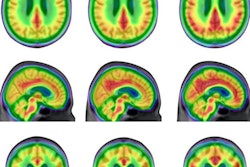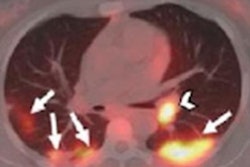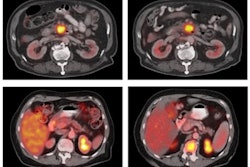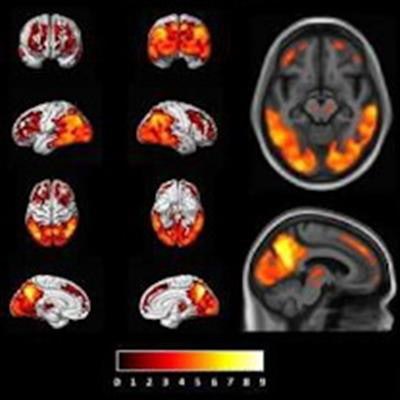
FDG-PET can identify whether mild cognitive impairment is associated with dementia with Lewy bodies or with Alzheimer's disease, two neurodegenerative conditions that can be indistinguishable in later stages, according to a study published July 4 in NeuroImage: Clinical.
Researchers analyzed brain patterns on FDG-PET in patients with mild cognitive impairment who subsequently progressed to dementia with Lewy bodies and Alzheimer's disease; they found different patterns of hypometabolism between the two diseases. The finding may have a significant impact on how the diseases are identified and treated early on.
"FDG PET abnormalities are present as early as the prodromal phase of [dementia with Lewy bodies] and regional FDG PET signatures can accurately distinguish prodromal [dementia with Lewis bodies] and prodromal Alzheimer's disease," wrote lead author Dr. Kejal Kantarci and colleagues at the Mayo Clinic in Rochester, MN.
Dementia with Lewy bodies and Alzheimer's disease have been identified as separate diseases, but differentiating between the two remains difficult. Both are among the most common neurodegenerative diseases. Moreover, the diseases can occur together in late stages.
Previous FDG-PET studies have shown that patients with dementia with Lewy bodies have hypometabolism in the brain's parieto-occipital cortex and a relatively normal cingulate island sign -- a pattern of brain metabolism in the posterior cingulate that literally has the appearance of an island on scans. The cingulate island sign has been described as a useful radiological differentiator between dementia with Lewy bodies and Alzheimer disease, in which the sign is not present.
In this study, Kantarci and colleagues compared normal patterns of brain hypometabolism on FDG-PET with scans from groups of patients who progressed from mild cognitive impairment to dementia with Lewy bodies or Alzheimer's disease. They then compared the groups with dementia with Lewy bodies and Alzheimer's disease to identify any significant "metabolic signatures" between the groups.
The researchers identified 148 patients diagnosed with mild cognitive impairment who had FDG-PET scans at baseline in 2006. During annual exams until 2019, 17 patients progressed to dementia with Lewy bodies and 41 progressed to Alzheimer's disease dementia.
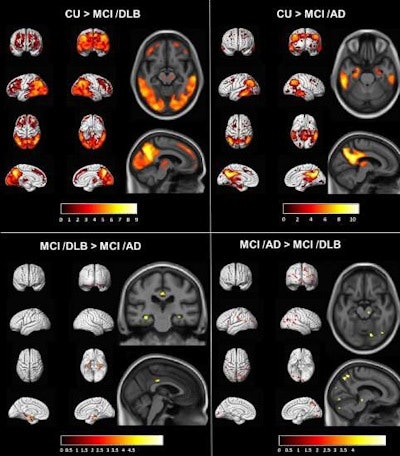 Voxel-based analysis comparing standardized uptake value ratio (SUVr) on FDG-PET scans of patients with mild cognitive impairment and dementia with Lewy bodies (MCI-DLB), mild cognitive impairment and Alzheimer's disease (MCI-AD), and clinically unimpaired (CU) controls. Maps of these comparisons were displayed at the p < 0.001 level with the t-values displayed in the color bar. The voxel-based regional differences in FDG SUVr in MCI groups compared to controls were corrected for multiple comparisons using family-wise error correction. Because there were no differences identified between the MCI-DLB and MCI-AD groups after correction for multiple comparisons, the uncorrected results are displayed. Image courtesy of NeuroImage: Clinical.
Voxel-based analysis comparing standardized uptake value ratio (SUVr) on FDG-PET scans of patients with mild cognitive impairment and dementia with Lewy bodies (MCI-DLB), mild cognitive impairment and Alzheimer's disease (MCI-AD), and clinically unimpaired (CU) controls. Maps of these comparisons were displayed at the p < 0.001 level with the t-values displayed in the color bar. The voxel-based regional differences in FDG SUVr in MCI groups compared to controls were corrected for multiple comparisons using family-wise error correction. Because there were no differences identified between the MCI-DLB and MCI-AD groups after correction for multiple comparisons, the uncorrected results are displayed. Image courtesy of NeuroImage: Clinical.PET/CT operating in 3D mode (GE Healthcare) was used to acquire PET images. Patients were injected with an average of 296 MBq of FDG. Following a 30-minute FDG uptake period, four 3.75-minute frames were obtained.
Patients with mild cognitive impairment who progressed to dementia with Lewy bodies had widespread hypometabolism on FDG-PET compared with the normal group. The quantitative cingulate island sign ratio was higher in the group that had dementia with Lewy bodies compared to the group with Alzheimer's disease.
In addition, voxel-based analysis revealed higher FDG uptake in the posterior-mid cingulate region in those with dementia with Lewy bodies compared with patients with Alzheimer's disease, a finding that has not been demonstrated when comparing patients with these diseases, the authors noted.
"Imaging biomarkers that show abnormalities at the prodromal stage, and that distinguish between patients with mild cognitive impairment who will progress to probable [dementia with Lewis bodies] from those who progress to Alzheimer's disease dementia are needed for the evaluation of effective treatments early in the disease course," the researchers concluded.




